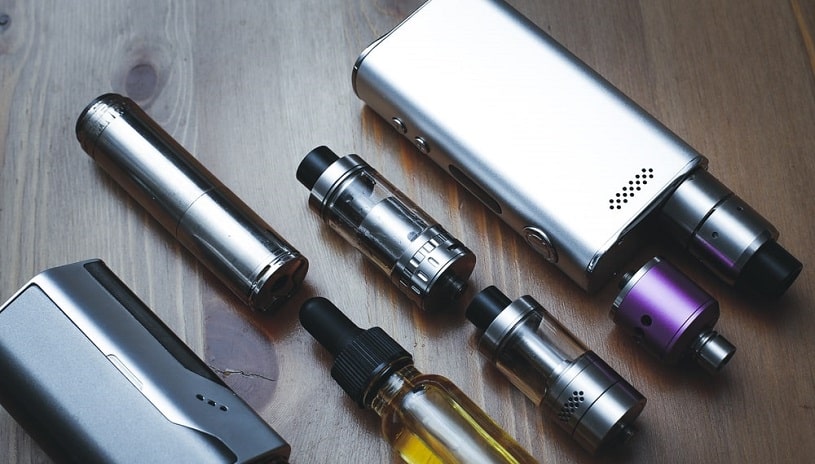Dangers of Vaping: Is There a Vaping Addiction?

While a lot of people turned to e-cigarettes in the hopes of avoiding cancer and health risks, research from the American Association for the Advancement of Science believes that vaping is far from benign. Electronic cigarettes were first introduced commercially back in 2008. They have continued to gain popularity in recent years. With many still oblivious to the dangers of vaping, it’s not difficult to see why related illnesses and deaths have been on the rise. Read on to learn about e-cigarettes, why they are so popular, and the health effects of vaping.
Table Of Contents:
What is Vaping and How Did it Become So Popular?
Vape is another term used to describe electronic nicotine delivery systems (ENDS), personal vaporizers, or electronic cigarettes. It is the practice of inhaling the vapor from an e-liquid through a vaporizer. To vape, one needs the atomizer, e-liquid, inhaler piece, and battery.

E-cigarettes are battery-powered devices that contain nicotine mixed with glycerin and propylene glycol and different types of flavorings. The liquid is then heated into a vapor that one can inhale. Electronic cigarettes were first introduced to help traditional smokers quit. Smoking e-cigarettes eliminates the lingering scent of cigarettes and conventional chemicals and toxins found in them. E-cigarettes have become increasingly popular, thanks to the exotic liquid flavors and new portable devices.
Nonetheless, research now indicates that e-cigs could be as harmful as conventional cigarettes.
Statistics of Electronic Cigarette Use
A study conducted by researchers at the University of Southern California showed that 13% of high school students either vaped or smoked in 2014.
A report published on the Centres for Disease Control and Prevention provides the following statistics on e-cigarette use amongst Americans:
- Between 2011 and 2018, the number of high school students in America who vape increased from 220,000 to 3.05 million.
- The number of middle school students who use e-cigarettes increased from 60,000 in 2011 to 570,000 in 2018.
- The significant rise in the use of e-cigarettes in the US between 2017 to 2018 is linked to the production of vaporizers shaped like USB drives.
Moreover, in 2020, 3.6 million middle and high school students were current users of electronic nicotine delivery systems. According to a survey held in 2013-2014, 81% of youth smokers admitted that the primary reason for the use of vaporizers was the availability of different flavors, like fruit, mint, or candy.
Dangers Of Vaping
Although vaporizers lack cancer-causing elements found in conventional smoking, studies now show that their use could harm one’s health and immune system. It’s been demonstrated that vaping inhibits the function of 358 genes associated with infection-fighting compared to smoking, which only inhibits 53 genes.

Although tobacco cigarettes are still relatively more harmful, there’s no denying the dangers of vaping to the body.
Below are the various vaping dangers users are exposed to:
Cardiovascular Damage
Studies have shown that e-cigarettes can cause severe cardiovascular damage. Research unveiled at the 68th Annual Scientific Session of the American College of Cardiology showed that adults who regularly vaped have a 34% chance of having a heart attack. The research also showed that vapers are 25% more likely to develop coronary artery disease compared to non-vapers.
Lung Damage
Among the most prominent dangers of vaping is lung damage. The fumes from a vape contain several harmful chemicals that could potentially damage the lungs when inhaled. The vape fume contains diacetyl which could harm tiny passageways in the lungs. Other dangerous chemicals that could damage the lungs are acrolein and formaldehyde, which can cause lung disease.
Vape-related Illness and Vaping Deaths
E-cigarettes can cause health complications and may even lead to death. A common health complication is the e-cigarette or vaping product use-associated lung injury (EVALI).
A national outbreak of EVALI in 2019 lead to further investigations by the Centers for Disease Control and Prevention on the true nature of the disease. This outbreak was the cause of a number of vaping deaths. It was found that EVALI is caused by vitamin E acetate, a chemical found in THC oil. Although vitamin E provides nutritional value when ingested, vitamin E acetate can cause damage to the lungs when inhaled.
EVALI is most commonly associated with Dank Vape. It is a product brand that contains THC. Tetrahydrocannabinol (THC) is the primary psychoactive ingredient that is found in marijuana. Therefore, vapers have a higher probability of developing EVALI when they vape marijuana.
As of 2019, around 2,807 people in the US had been hospitalized due to EVALI, with 68 recorded vaping deaths. The CDC recommends that vitamin E should not be added to vape products to prevent more disease cases.
Vape Explosion
Another danger associated with electronic nicotine delivery system use is that a vaporizer can explode. If this explosion occurs while it’s being used, it can cause severe harm to the user. In 2019, a 17-year-old boy was hospitalized after his jaw was shattered by a vape explosion.

A lot has been said about how and why vaporizers explode, but some of the most common causes include battery failure, using a bad charger, improper storage, or overcharging. Considering how easy it is to buy bad batteries or chargers without knowing, users are always at risk of a vape explosion.
According to an FDA Guide, Here’s How to Avoid a Vape Explosion:
- Use vape devices with safety features like vent holes and firing buttock locks
- Place loose batteries in a case to prevent contact with metal objects
- Don’t charge your vape device with a tablet or phone charger
- Never charge your vape device overnight to avoid overcharging
- If batteries are wet or damaged, be sure to replace them
Seizures
Although seizures may be one of the less common vaping dangers, more cases have begun to turn up recently. Usually, seizures are not among nicotine effects, when inhaled in low amounts, as is the case with tobacco cigarettes.
However, a large dose or a nicotine overdose can cause seizures. Unfortunately, vapers aren’t always sure how much nicotine they inhale from their pods as vaporizers have different nicotine levels. This makes it difficult for vapers to control the level of nicotine they inhale. It means people tend to inhale more of the substance through vaping vs. smoking traditional cigarettes.
Other Side Effects of Vaping
Apart from the dangers of vaping listed above, there are several other vaping side effects that could pose a threat to users’ health.
They Include:
- Coughing
- Shortness of breath
- Headaches
- Nicotine addiction
- Gum inflammation
- Slowed brain development in people under age 25
Another common concern among health officials and law enforcement is that more people are now using vaporizers to ingest synthetic drugs, flakka, and other marijuana-related compounds. Given the freedom to vape in public places, people are taking advantage of using these drugs in open areas.
Vaping Vs. Smoking
Although e-liquid and vape pens lack the same toxins found in regular cigarettes, the truth is that they still contain nicotine. This substance can be addictive, not to mention that it also causes symptoms of nicotine withdrawal (especially if nicotine is ingested in high amounts, which can be the case when people use devices called box mods that produce high volumes of vapor).
Such symptoms include anxiety, irritability, restlessness, insomnia, and more. CDC is quoted as saying that nicotine is as addictive as cocaine, alcohol, and heroin.

Many people use vaporizers because of the widespread belief that they are safer than regular cigarettes. This is true to some extent. Although vapers are exposed to several vaping dangers, it’s still not quite as deadly as tobacco cigarettes. Regular cigarettes increase the risk of lung cancer, heart disease, stroke. While heart disease is also one of the effects of vaping, smokers are more likely to develop the condition from smoking tobacco cigarettes.
However, e-cigarettes are believed to be more addictive than regular cigarettes. With the varying amount of nicotine in vaporizers, there’s a good chance many users are inhaling large doses. The higher the amount of nicotine inhaled, the quicker it becomes addictive.
Comparing vaping vs. smoking, e-cigs come out tops in addiction, while tobacco smoking is more dangerous in terms of side effects.
Vaping Addiction
Vaping deaths and illnesses are not the only problems vapers have to worry about. Addiction is also one of many vaping side effects. Nicotine is a highly addictive substance that’s found in many vaporizers. It is responsible for the addictive nature of vapes. As users continue to smoke vapes, their brain becomes used to the feeling of nicotine and may exhibit withdrawal symptoms if they stop.
Should E-cigs be an Alternative to Smoking?
Is there a really big difference concerning the safety of vaping vs. smoking? E-cigarettes have long been promoted as the safer alternative to smoking tobacco cigarettes. Unfortunately, they are not as safe as people imagine. E-cigs pose many health risks, and there have been several reported cases of vaping deaths over the years.
Also, e-cigarettes are especially dangerous for young adults. Studies have shown that nicotine can harm the development of the adolescent brain. From all available records and reports, e-cigarettes should not be considered a safe option for tobacco smoking. While it may not be as deadly, it’s definitely not harmless.

The best way to avoid the dangers associated with e-cigs and smoking is to quit entirely. It takes away the burden of worrying about what is safe and what isn’t. Luckily, there are treatment options available for those who are determined to quit smoking cigarettes or vapes. Regardless of the way of intake, it’s exactly nicotine that makes people come back to smoking. Therefore, first of all, nicotine addiction should be treated. It can be done with the help of rehab facilities or replacement therapy. Everyone chooses their own way, and the truth is, recovery is possible, no matter how long one has been smoking.
Hope Without Commitment
Find the best treatment options. Call our free and confidential helpline
Most private insurances accepted
Page Sources
- U.S. Food and Drug Administration, Vaporizers, E-Cigarettes, and other Electronic Nicotine Delivery Systems (ENDS), 2020. https://www.fda.gov/tobacco-products/products-ingredients-components/vaporizers-e-cigarettes-and-other-electronic-nicotine-delivery-systems-ends
- Micah G. Katz, M.D., and Katie W. Russell, M.D., The New England Journal of Medicine, Injury from E-Cigarette Explosion, 2019. https://www.nejm.org/doi/full/10.1056/NEJMicm1813769
- Statement from FDA Commissioner Scott Gottlieb, M.D., and Principal Deputy Commissioner Amy Abernethy, M.D., Ph.D., on FDA’s ongoing scientific investigation of potential safety issue related to seizures reported following e-cigarette use, particularly in youth and young adults, 2019. https://www.fda.gov/news-events/press-announcements/statement-fda-commissioner-scott-gottlieb-md-and-principal-deputy-commissioner-amy-abernethy-md-phd
- Jessica L. Barrington-Trimis, PhD, Robert Urman, PhD, and Rob McConnell, MD. E-cigarettes, Cigarettes, and the Prevalence of Adolescent Tobacco Use. August, 2016. https://www.ncbi.nlm.nih.gov/pmc/articles/PMC4960723/
- Karen A. Cullen, Bridget K. Ambrose, Andrea S. Gentzke, Benjamin J. Apelberg, Ahmed Jamal, Brian A. King, Notes from the Field: Use of Electronic Cigarettes and Any Tobacco Product Among Middle and High School Students - United States, 2011-2018. https://www.cdc.gov/mmwr/volumes/67/wr/mm6745a5.htm?s_cid=mm6745a5_w
- Elizabeth M. Martin, Phillip W. Clapp, and Ilona Jaspers. E-cigarette Use Results in Suppression of Immune and Inflammatory-response Genes in Nasal Epithelial Cells Similar to Cigarette Smoke. July, 2016. https://www.ncbi.nlm.nih.gov/pmc/articles/PMC4967187/
- Tips to Help Avoid "Vape" Battery Explosions. September, 2020. https://www.fda.gov/tobacco-products/products-ingredients-components/tips-help-avoid-vape-battery-explosions>

 Authored by
Authored by  Reviewed by
Reviewed by 



